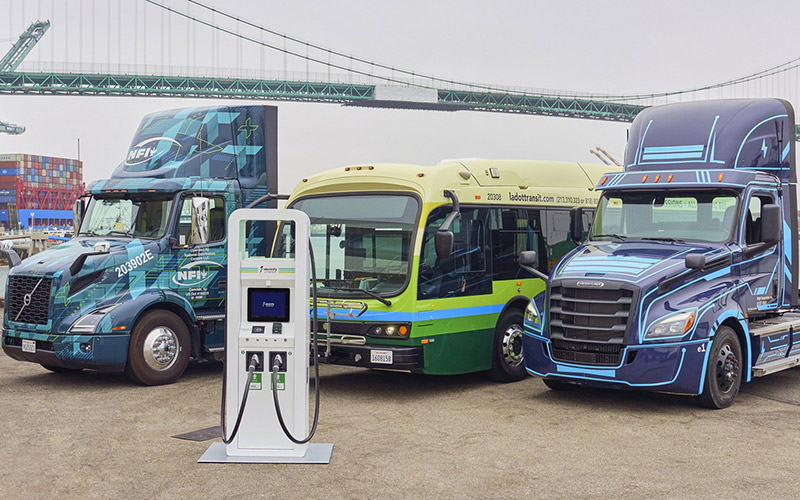
CARB Approves Historic $2.6 Billion Investment — Largest To Date — For Clean Cars, Trucks, Mobility Options
Plan represents largest-ever investment in equity, expanding clean transportation in communities hardest hit by pollution.
The California Air Resources Board approved a far-reaching $2.6 billion investment plan that ensures all Californians benefit from our state’s transition to zero-emission transportation. Supported projects range from incentives for cleaner trucks and buses, and mobility options such as bike- and car-sharing, to consumer rebates for clean cars.
This year’s investment dollars focus largely on underserved communities, including low-income communities and those disproportionately burdened by environmental pollution, as well as small truck fleets. Marking the state’s largest investment in equity, it is estimated that more than 70% of the $2.6 billion Fiscal Year 2022-23 Funding Plan for Clean Transportation Incentives will benefit priority populations.
“California is leading the world in accelerating clean energy and cutting pollution, and this $2.6 billion investment will make it more affordable for our communities to transition to zero-emission vehicles,” Governor Gavin Newsom said. “This move, and the rest of the $10 billion ZEV package we enacted, will provide the cost-saving incentives people need to make the transition — part of our overall $54 billion California Climate Commitment. These collective efforts are exactly how we will phase out new gas-powered cars by 2035.”
The investment plan recognizes that to meet the state’s clean air and climate goals California needs more clean cars, trucks and buses along with community-led efforts to create walkable, bikeable, transit-friendly places for everyone.
“California is backing up our commitment to clean the air in overburdened communities with the largest state investment yet in zero-emission vehicles and sustainable transportation,” CARB Chair Liane Randolph said. “These incentives continue to support our equitable transition to zero-emission cars, as well as accelerate the commercialization of zero-emission technologies for trucks and buses and provide support for small owner-operator truck fleets. They also focus on improving access to clean mobility options in communities hardest hit by pollution. The Board’s action today will enable us to surge ahead in our effort to move away from fossil fuels and reach carbon-neutrality by 2045 or sooner.”
The investments are part of California’s comprehensive strategy for improving air quality and reducing greenhouse gas emissions in the transportation sector, the state’s largest source of air pollution and climate-changing gases. The 2022 state budget expands these efforts by $6.1 billion — in addition to an existing multi-year $3.9 billion commitment — for a total investment of $10 billion through fiscal year 2026-27 to decarbonize California’s most polluting sector.
The goal is to accelerate California’s transition to clean cars, trucks, and off-road equipment to meet Governor Newsom’s Executive Order to reach 100% ZEV sales for cars and medium-duty trucks by 2035, and for heavy-duty trucks by 2045. The funds are part of the administration’s California Climate Commitment.
Funded projects include:
- $2.2 billion for clean trucks and buses, and off-road equipment. This includes over $2 billion for zero-emission trucks and buses and off-road equipment including school buses, transit buses, and drayage trucks, $33 million for financing for small truck fleets transitioning to cleaner technologies, and $135 million for demonstration and pilot projects, including commercial harbor craft.
- $381 million for clean transportation equity projects. This includes $326 million for vehicle purchase incentives and $55 million for clean mobility investments.
Significant program changes
This year’s plan includes program changes to better address economic and market concerns, including a big boost to clean car purchase incentives for lower-income buyers and increases support for small fleets. Changes include:
Vehicle Purchase Incentives
- Significant support for low-income consumers looking to purchase an electric car: Up to $15,000 in incentives for new electric vehicles without having to scrap an older vehicle and up to $19,500 for those who have an older car to scrap – an increase of $3,000 from current incentive levels.
- Streamlines and aligns programs: Simplifies income eligibility tiers to at or below 300% of the Federal Poverty Level and offers $2,000 prepaid electric vehicle charge cards for low-income consumers.
Heavy-Duty and Off-Road Equipment
- Small fleet support: Introduces tiered voucher amounts to increase support for small fleets while encouraging early adoption of zero-emission technologies and large-scale deployments of zero-emission trucks in disadvantaged communities.
- Support for commercial harbor craft: Dedicates $60 million for cleaner commercial harbor craft.
This plan builds on the success of previous funding plans over the past 13 years that have invested more than $4 billion for clean-transportation projects in California. The bulk of these funds have come from California Climate Investments, a statewide initiative that puts billions of cap-and-trade dollars to work reducing greenhouse gas emissions, strengthening the economy and improving public health and the environment — particularly in disadvantaged communities. About 58% of these funds have benefitted these priority populations.
These investments have put more than 400,000 zero-emission cars, trucks, transit buses, school buses, and freight equipment into operation in California.